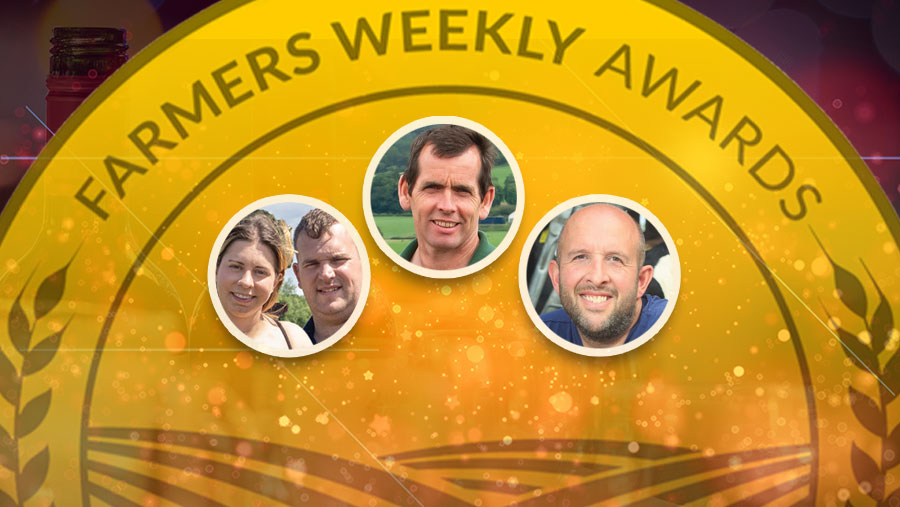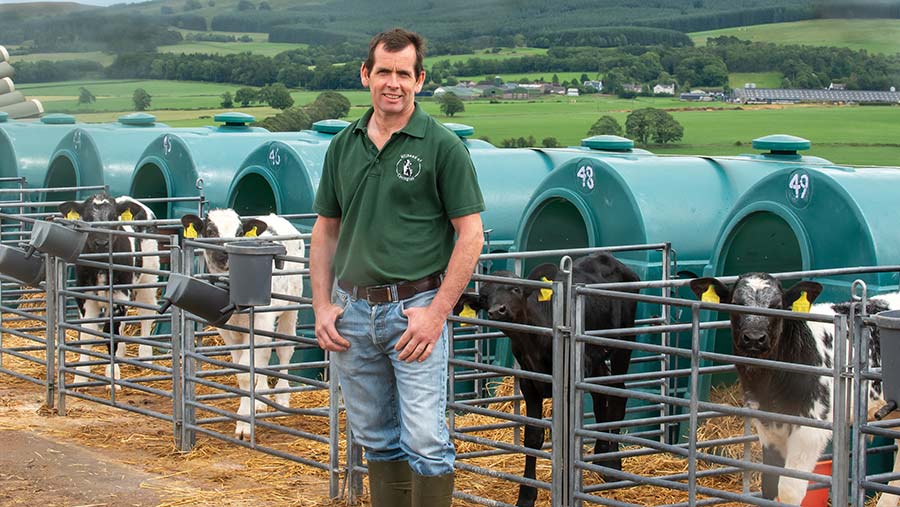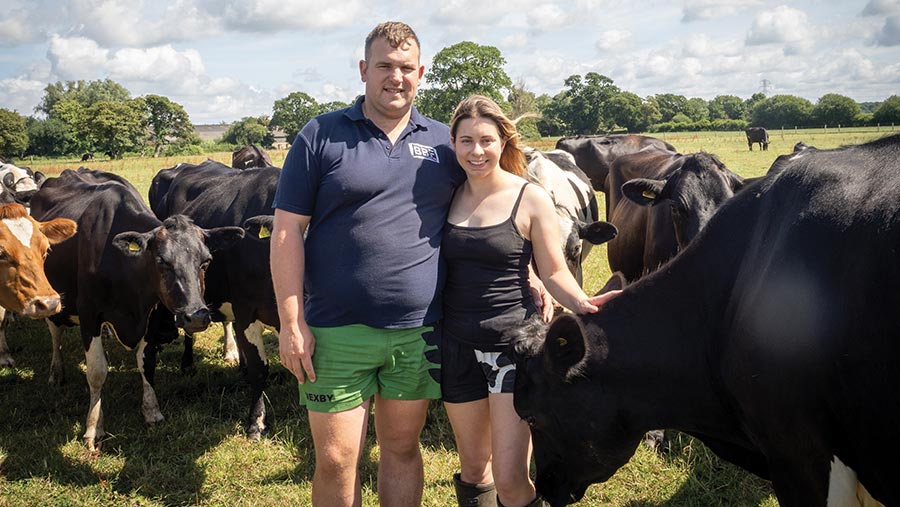Farmers Weekly Awards 2023: Dairy Farmer of the Year finalists

This year’s finalists run contrasting systems with herds ranging from 270 to 400 cows, but all three are actively setting targets and are keen to adopt new ideas, analyse data and use technology to develop their businesses.
See also: See the full 2023 Farmers Weekly Awards shortlist
The finalists
William Baillie
Hillhead Farm, Lanarkshire
Josh Fincham and Lauren Pincombe
Hampreston Manor Farm, Dorset
Andrew Gillman
Statfold Farm, Staffordshire
The judges
The judging team visited each finalist for a three-hour interview.
Catherine Pickford
Last year’s winner
Shirley Macmillan
Farmers Weekly deputy livestock editor
Gaynor Wellwood
Independent consultant
William Baillie
Hillhead Farm, Biggar, Lanarkshire

William Baillie © Angus Findlay
Farm facts
- 156ha (385 acres) owned; 81ha (200 acres) rented; second unit for heifers 400 cows fully housed
- Milking three times a day
- Average yield 11,452 litres at 4.07% butterfat and 3.39% protein
- High-fibre, low-potassium, dry cow silage
- One total mixed ration for milking cows
- Selling to Yew Tree Dairies on solids contract
- On-farm vending machine
Beef and sheep farmer’s son William Baillie borrowed money in 1997 to buy his own farm, 50 dairy cows and quota at 50p/litre.
Since then, his passion for dairy and a businesslike approach have helped him develop a modern, simple, high-yielding system with 400 cows.
He has repaid debt and invested in a joint venture with a spring block-calving herd. More recently, a new milk contract helped take a step into on-farm diversification.
Together with his wife, Jennifer, William is now planning succession, progressing the business to include their daughters Abbie and Eva and son Finlay in a vending machine enterprise, an on-site bakery and farm tours for the public, using social media to connect with their customers.
The business
William’s aptitude for detail, figures and data was developed in his dairy discussion group, which introduced him to regular benchmarking.
He says focusing on numbers and comparing himself with a variety of systems helped him become more profitable.
This experience also established his goals, targets and ways to monitor progress.
His purchased feed cost target has risen from 8p to 10p/litre, but he is conscious that this drives the bottom line.
“That’s why I’m looking at milk from forage – we’re getting about 4,000 litres – because it goes hand in hand with feed cost,” he says.
“Fixed costs are hard to shift: labour is 5p/litre and I’ve got to accept that if I want staff; I don’t want to do it all myself.”
Technical performance
Yield has stabilised as William has focused on milk solids and economical production. Cross-breeding means younger animals are yielding 850kg.
He also runs a single milking group on one ration, aiming for a long, level lactation.
“We don’t have many cows giving over 60 litres/day, but a lot are still yielding 30-40 litres in late lactation,” he says.
However, first-lactation heifers are in a separate group until back in-calf. “Yield definitely rose by 10%, there is less bullying, heifers eat more and fertility is better,” says William.
He also runs a slow milkers’ group last through the parlour to speed up milking efficiency.
Compact feeding and multicut silage have improved feed quality and reduce ration sorting, while zero grazing from April to November has cut costs.
“We have reduced concentrates by 1kg a head, cheapened the ration and less clamp space is needed,” he says.
Heat detection collars, machine-washable cloths in the parlour and biological fly control in cow housing have also been introduced.
Future plans
William and Jennifer’s milk hut, established in 2021, offers milkshakes, coffees and homemade cakes, and customers travel up to one-and-a-half hours to enjoy the amazing views.
Although only 1-2% of milk is sold through the vending machine, it already contributes 12% of milk income.
He is still hands-on and enjoys milking five mornings a week, but William is thinking about the next generation.
Abbie is his trainee herd manager and a building conversion will create an industrial kitchen for Eva, the business baker. Sixteen-year old Finlay is an apprentice on the farm.
He recognises that growing the business becomes more about managing people, not cows.
He has used Jennifer’s experience as a physiotherapist in the NHS to set up a good employment package, including a five-day working week, induction programmes, protocols and a fully-equipped staff room.
What the judges say
Passion, purpose and delivery: William is very clear and focused on what he wants to do. He is trying to improve milk solids, not yield, with concern for cow welfare.
William Baillie summary
The judges liked
- Passion and enthusiasm for dairy farming and staff development
- Tidy farm
- Attention to detail
- Clear targets
- Making good use of benchmarking
- First-lactation heifer group
- Simple, high-yielding system
The numbers
29% Pregnancy rate
19% Replacement rate
11% Mastitis rate
<15% Percentage of cows treated with antibiotics at drying off
96 Percentage of first calvers getting back in-calf
Josh Fincham and Lauren Pincombe
Hampreston Manor Farm, Wimborne, Dorset

Josh Fincham and Lauren Pincombe © Kathy Horniblow
Farm facts
- Autumn-block calving
- 270 cross-bred cows plus 140 followers
- Self-feed silage in winter, with 70% maize
- 6,500 litres a cow; 540kg milk solids
- New Zealand genetics
- 310 grazing days
- Selling milk to Blackmoor Vale Dairy
- Dry cows graze standing hay
- 89ha (220-acre) grazing platform
- 10t/ha grass dry matter
New entrant Josh Fincham started his contract farming agreement in 2020, on a 300-cow autumn-block herd, buying the outgoing contractor’s youngstock and 25% of the farm’s cows.
Today, Josh and his fiancée, Lauren Pincombe, a vet, are on course to own 50% of the herd and next year will be debt-free.
Josh took on the herd, which was being run on rotational grazing and self-feed silage, and has continued to make changes to reduce costs and refine performance, such as cutting cow numbers by 30 to allow more space.
Josh is now targeting 7,000 litres from 1.2t of cake.
The business
The workforce includes a full-time member of staff, plus a student, to create a team structure with flexibility and time for projects such as installing new cubicle mats, as well as allowing everyone to have a good work/life balance.
Josh’s main challenge has been his switch in role and mindset.
“You are no longer just milking cows and scraping up: you have to make all the management decisions and manage a team of staff. Every decision affects herd performance and profit,” he explains.
His two discussion groups have provided valuable support, and regular meetings with the farm owners have given him experience in keeping track of invoices, spend and budgets.
Josh works with two other farms to get good deals via tonnage for cake, chemicals and fertiliser.
“Maize seed is bought on the day we harvest our maize, for a good deal,” he says. “I buy fertiliser in April and June.”
Technical performance
Milk from forage has risen to 3,617 litres through more grazing days.
Calving has been brought forward two weeks to 10 August to avoid having to buffer-feed milking cows; instead they are dried off onto standing hay in early June.
Josh has drilled 20ha (50 acres) of herbal leys to combat drought, and a trial paddock of turnips for dry cows.
The calving block has been tightened to nine weeks, after three years of data showed that very few cows calving in the last four weeks got back in-calf.
This has also created a definite break between calving and serving.
Lauren’s calf rearing has introduced consistency and attention to detail, resulting in calves weaning at six weeks, having doubled their birthweight and eating 2kg/day of concentrates.
Replacements are trained to cubicles and self-feed silage in April, when cows are out full-time.
“We see the benefit as they eat over the wire and lie in the cubicles,” says Josh.
“We also run them through the parlour because it is a quieter time of lactation, and we definitely retain those heifers in the herd. They don’t lose weight after calving due to bullying.”
Future plans
Josh paid for new 44mm-deep mats in the 285 cubicles from his profit, and is paying 10% towards a new slurry separator.
Teat scoring has identified some teat-end damage, and he is keen to invest in automatic cluster removal to improve udder health.
This would cost about £20,000 for the parlour, which he reckons would be recouped within 18 months by earning a Bactoscan bonus.
He owns 130 cows and 60 youngstock, buying cows out of his profit share rather than a bank loan.
“Buying our own dairy farm is the dream, but we could scale back to just owning a youngstock unit and look for a second contract-farming agreement,” he says.
What the judges say
Technically efficient, good attention to detail, immaculate dairy office, parlour and equipment; Josh and Lauren make a good team with complementary skills and are good with their staff.
Josh Fincham and Lauren Pincombe summary
The judges liked
- Clear business goals
- Highly competent with numbers, targets and budgets
- Determined to make a go of it
- Willingness to take advice (attending discussion groups)
- Cows look healthy
- Passionate about calf rearing
- Tidy farm
The numbers
9 Autumn calving block in weeks
310 Days of grazing in 2022
1.5t Concentrates a cow
56% Percentage of milk from forage
160,000 Cell count (cells/ml)
Andrew Gilman
Statfold Farm, Tamworth, Staffordshire

Andrew Gilman © Tim Scrivener
Farm facts
- Tenant on third-generation AHA
- 182ha (450 acres)
- Double cropping maize and grass on 65ha (160 acres)
- Multicut silage starting mid-April
- 307 cows
- 130 replacement heifers
- Fully housed
- 10,500 litres at 4.39% butterfat and 3.53% protein
- Three-times-a-day milking
- One ration for milkers
- Selling milk to Arla
New technology and practical research that can be used on farm are behind Andrew Gillman’s drive for efficiency and profitability.
Despite being a tenant, he has invested heavily in new facilities for youngstock and transition cows, while also expanding from 200 to 300 cows.
Now he is planning succession, having set the farm up for technical performance and a good work/life balance.
He would like to take more time off the farm over the next decade, spending more time with his children, and be in a position to nurture the next generation, should they take on the farm.
The business
As an AHDB strategic dairy farm, Andrew has welcomed the technical input and the chance to meet other dairy farmers.
He benchmarks among his Arla peers and is part of a national discussion group sharing new ideas.
“It’s the invaluable conversations you have and getting away from the farm: you get a spring in your step afterwards,” he says.
He is an early adopter: automatic heat detection was installed 15 years ago; the milk silo is 10 years old; and the farm has introduced compact feeding and multicut silage. Slurry scraper collectors are next on his list.
Genomic testing heifers at two months is now identifying which are the most feed-efficient and helping to tailor Andrew’s breeding programme.
Current calves have the potential to give 105% more combined fat and protein than first-lactation heifers.
“Pedigree is subjective, but genomic is objective and has science to it,” he says.
Technical performance
Youngstock were previously kept in traditional brick buildings that were not easy to work with, and any feeding, handling or bedding took a lot of time – even needing someone to open the doors.
“It took three people chasing a heifer to serve it,” he says.
“Now we have self-locking yokes. Calves go in at weaning, aged 10 weeks, until they are pregnancy-diagnosed in-calf. We can serve and TB-test easily.”
Andrew calculated his payback at two years by reducing age at first calving from 25 to 23 months through improved management and feeding, not to mention a better working environment for staff.
A bespoke transition shed with sand cubicles, locking yokes and no blind alleys has similarly proven itself. Dry cows move into it three weeks pre-calving.
“Cows stay in established groups of two to three at calving and continue to eat and drink normally. There is no social stress.
“We have had very little post-calving issues such as left-displaced abomasum or metritis.
“Our colostrum quality and quantity have got better, and cows have gone into milk better,” he says.
Future plans
A recent change in dairy staff is prompting Andrew to work on his people-management skills, starting with reintroducing weekly team meetings and giving staff a chance to visit other dairy farms in the area to gain new ideas.
“Staff management takes a lot of time and thought, but I feel I get a lot from building relationships with people and seeing things from their point of view,” he says.
“I’d like to get to 300 cows in milk and create a sustainable, profitable business, pay off debt and leave it in a good solid position for the next generation, if they want to take it on.
“But I’d like my children to get a degree outside of agriculture to help them be more equipped for the farm.”
What the judges say
Andrew makes good use of benchmarking and advice, is good at adopting new innovations and is keen on research. He achieves a healthy balance of work and lifestyle.
Andrew Gilman summary
The judges liked
- Impressive investment in heifer rearing
- Comfy cubicles and good cow health
- Transition shed has low stocking rate
- Tidy, well-laid out farm
- Close links with research centre at Nottingham university
- Values discussion group and networking with other farmers
The numbers
83% Percentage of cows dried off without antibiotics
12 Energy level in multicut silage (MJ/kg metabolisable energy)
13 Rolling feed cost (p/litre)
23 Age in months at first calving
2 Payback in years for new youngstock shed
The FW 2023 Dairy Farmer of the Year is sponsored by Virgin Money
Sponsor’s message
 “It is great to celebrate the hard work and dedication that goes on across dairy farming. This year’s finalists demonstrate the excellence in the sector and the innovation and attention to detail needed to succeed where margins are small and returns volatile. Our Virgin Money team congratulate all the finalists.”
“It is great to celebrate the hard work and dedication that goes on across dairy farming. This year’s finalists demonstrate the excellence in the sector and the innovation and attention to detail needed to succeed where margins are small and returns volatile. Our Virgin Money team congratulate all the finalists.”
Brian Richardson, UK head of agriculture, Virgin Money
